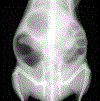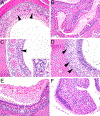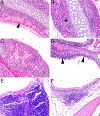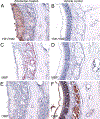The Endothelin-A Receptor Antagonist Zibotentan Induces Damage to the Nasal Olfactory Epithelium Possibly Mediated in Part through Type 2 Innate Lymphoid Cells
- PMID: 30595110
- PMCID: PMC7357205
- DOI: 10.1177/0192623318816295
The Endothelin-A Receptor Antagonist Zibotentan Induces Damage to the Nasal Olfactory Epithelium Possibly Mediated in Part through Type 2 Innate Lymphoid Cells
Abstract
Zibotentan, an endothelin-A receptor antagonist, has been used in the treatment of various cardiovascular disorders and neoplasia. Castrated athymic nude mice receiving zibotentan for a preclinical xenograft efficacy study experienced weight loss, gastrointestinal bloat, and the presence of an audible respiratory click. Human side effects have been reported in the nasal cavity, so we hypothesized that the nasal cavity is a target for toxicity in mice receiving zibotentan. Lesions in the nasal cavity predominantly targeted olfactory epithelium in treated mice and were more pronounced in castrated animals. Minimal lesions were present in vehicle control animals, which suggested possible gavage-related reflux injury. The incidence, distribution, and morphology of lesions suggested direct exposure to the nasal mucosa and a possible systemic effect targeting the olfactory epithelium, driven by a type 2 immune response, with group 2 innate lymphoid cell involvement. Severe nasal lesions may have resulted in recurrent upper airway obstruction, leading to aerophagia and associated clinical morbidity. These data show the nasal cavity is a target of zibotentan when given by gavage in athymic nude mice, and such unanticipated and off-target effects could impact interpretation of research results and animal health in preclinical studies.
Keywords: ILC2; TH2-mediated; endothelin-A receptor antagonist; gavage injury; nasal; olfactory epithelium; zibotentan.
Figures







Similar articles
-
Castration Determines the Efficacy of ETAR Blockade in a Mouse Model of Prostate Cancer Bone Metastasis.Endocrinology. 2019 Aug 1;160(8):1786-1796. doi: 10.1210/en.2019-00261. Endocrinology. 2019. PMID: 31173072 Free PMC article.
-
Preliminary study of the specific endothelin a receptor antagonist zibotentan in combination with docetaxel in patients with metastatic castration-resistant prostate cancer.Prostate. 2011 Sep;71(12):1264-75. doi: 10.1002/pros.21342. Epub 2011 Jan 26. Prostate. 2011. PMID: 21271613 Clinical Trial.
-
Combination therapy of zibotentan with cisplatinum and paclitaxel is an effective regimen for epithelial ovarian cancer.Can J Physiol Pharmacol. 2010 Jun;88(6):676-81. doi: 10.1139/Y10-053. Can J Physiol Pharmacol. 2010. PMID: 20628434
-
Zibotentan for the treatment of castrate-resistant prostate cancer.Expert Opin Investig Drugs. 2010 Jul;19(7):899-908. doi: 10.1517/13543784.2010.491822. Expert Opin Investig Drugs. 2010. PMID: 20497097 Review.
-
Dosimetry, toxicity and carcinogenicity of inspired acetaldehyde in the rat.Mutat Res. 1997 Oct 31;380(1-2):113-24. doi: 10.1016/s0027-5107(97)00130-9. Mutat Res. 1997. PMID: 9385393 Review.
Cited by
-
Castration Determines the Efficacy of ETAR Blockade in a Mouse Model of Prostate Cancer Bone Metastasis.Endocrinology. 2019 Aug 1;160(8):1786-1796. doi: 10.1210/en.2019-00261. Endocrinology. 2019. PMID: 31173072 Free PMC article.
-
Synthesis, characterization, biological evaluation, and molecular docking studies of new 1,3,4-oxadiazole-thioether derivative as antioxidants and cytotoxic agents.Heliyon. 2024 Mar 28;10(7):e28634. doi: 10.1016/j.heliyon.2024.e28634. eCollection 2024 Apr 15. Heliyon. 2024. PMID: 38576588 Free PMC article.
-
Endothelin Receptor Antagonists: Status Quo and Future Perspectives for Targeted Therapy.J Clin Med. 2020 Mar 18;9(3):824. doi: 10.3390/jcm9030824. J Clin Med. 2020. PMID: 32197449 Free PMC article. Review.
References
-
- Bates D, Mächler M, Bolker BM, Walker SC (2015). Fitting Linear Mixed-Effects Models Using lme4. Journal of Statistical Software, 67, 1–48.
-
- Clarkson-Jones JA, Kenyon AS and Tomkinson HK (2011). The disposition and metabolism of zibotentan (ZD4054): an oral-specific endothelin A receptor antagonist in mice, rats and dogs. Xenobiotica; the fate of foreign compounds in biological systems, 41, 784–796. - PubMed
-
- Clozel M, Maresta A and Humbert M (2013). Endothelin receptor antagonists. Handbook of experimental pharmacology, 218, 199–227. - PubMed
MeSH terms
Substances
Grants and funding
LinkOut - more resources
Full Text Sources

